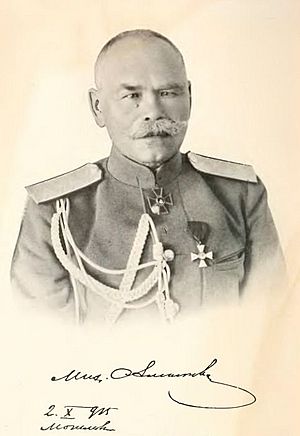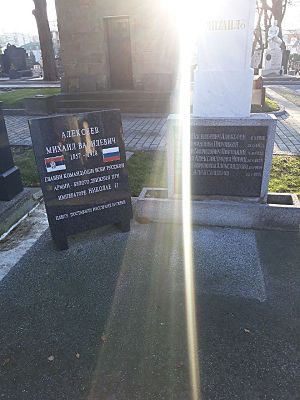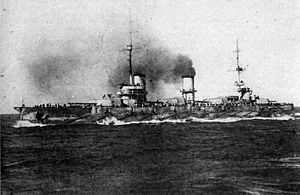Mikhail Alekseyev facts for kids
Quick facts for kids
Mikhail Alekseyev
|
|
|---|---|
 |
|
| Born | 15 November 1857 Vyazma, Smolensk Governorate, Russian Empire |
| Died | 8 October 1918 (aged 60) Ekaterinodar, Russian SFSR |
| Buried |
New Cemetery, Belgrade
|
| Allegiance | |
| Service/ |
|
| Years of service | 1876–1918 |
| Rank | General |
| Battles/wars | Russo-Turkish War (1877–1878) Russo-Japanese War World War I Russian Civil War |
| Awards | |
Mikhail Vasilyevich Alekseyev (Russian: Михаил Васильевич Алексеев) (born November 15, 1857 – died October 8, 1918) was an important general in the Imperial Russian Army. He served during World War I and the Russian Civil War. From 1915 to 1917, he was the Chief of Staff for Tsar Nicholas II. After the February Revolution, he became the commander-in-chief under the Russian Provisional Government. He later helped start the Volunteer Army during the Russian Civil War. He passed away in 1918 due to heart problems while fighting against the Bolsheviks.
Contents
Early Life and Military Career
Mikhail Alekseyev was born in Vyazma, a town in the Russian Empire. His father, Vasili Alekseyev, was an army captain. In 1873, Mikhail joined the army as a volunteer. He finished military school in 1876 and became an ensign.
He served as an assistant to General Mikhail Skobelev during the Russo-Turkish War (1877–1878). He was injured in a battle near Pleven, Bulgaria. He was promoted to lieutenant in 1881 and captain in 1883. In 1893, Alekseyev went to the Nicholas General Staff Academy. He later became a teacher there. By 1904, he was a major general.
Serving in the Russo-Japanese War
When the Russo-Japanese War began in 1904, Alekseyev became the Quartermaster General for the Russian 3rd Manchurian Army. This role meant he was in charge of supplying the army. For his service in the war, he received several awards, including a Gold Sword for Bravery. After the war, he returned to teaching military history. In 1908, he became the Chief of Staff of the Kiev military district. He was promoted to lieutenant general. By 1912, he was in command of the 13th Army Corps.
World War I Leadership
At the start of World War I, Alekseyev became Chief of Staff for the Southwestern Front. He helped plan a major Russian attack into Galicia. For his success, he received the Order of St. George. In March 1915, he became the overall commander of the Russian Northwestern Front.
In September 1915, Tsar Nicholas II took over as the supreme Commander-in-Chief. Alekseyev was then chosen to be the Chief of Staff for the General Headquarters, known as the Stavka. This meant he was in charge of all military operations from 1915 to 1917.
As Chief of Staff, Alekseyev was known for being flexible and able to adapt. However, he found it hard to change the political system. This system often allowed less skilled commanders to be promoted because of family connections or favoritism. Alekseyev was dedicated to the Allied cause. He led a successful summer attack in 1916. Even so, the Russian army could not fully use the benefits of this victory, and the war situation did not get much better.
Role in the Russian Revolutions
During the February Revolution of 1917, General Alekseyev sent messages to the Tsar from other generals. These messages advised the Tsar to give up his throne. This advice helped lead to the Tsar's decision to step down on March 15, 1917.
From March to May 1917, Alekseyev's role was unclear. He was the Commander-in-chief and an adviser to the Russian Provisional Government. However, he disagreed with the Soviets and the idea of making the army more democratic. In August 1917, Alekseyev became Chief of Staff of the Stavka again, under Commander-in-Chief Alexander Kerensky. His goal was to stop a movement led by General Kornilov from starting a civil war. He arrested General Lavr Kornilov and his men.
Founding the Volunteer Army
After the October Revolution in November 1917, Alekseyev left Petrograd. He arrived in Novocherkassk on November 15. With help from the Don Cossacks leader, General Alexey Kaledin, he created the Alekseev Organization. This group later became the main part of the Volunteer Army, which fought against the Bolsheviks.
In December, General Lavr Kornilov joined him. It was clear that Alekseyev and Kornilov would not always agree. They had different backgrounds and personalities. On December 31, Kornilov took military command of the Volunteer Army. Alekseyev took charge of civil matters, foreign affairs, and money. After Kornilov died, Alekseyev appointed Anton Denikin as the new commander of the Volunteer Army.
General Alekseyev had been sick for some time. He died of heart failure in Ekaterinodar in September 1918. He was first buried in a church crypt. Later, his family moved his remains to the New Cemetery, Belgrade, where they are today.
Awards and Recognition
Mikhail Alekseyev received many awards for his bravery and service:
- Order of St. Anne (1878, 1879, 1896, 1906)
- Order of St. Stanislav (1879, 1892, 1905)
- Order of St. Vladimir (1900, 1901, 1911)
- Golden Sword of St. George "for courage" (1906)
- Order of St. George Grade 4 (1914)
See also
 In Spanish: Mijaíl Alekséyev para niños
In Spanish: Mijaíl Alekséyev para niños



